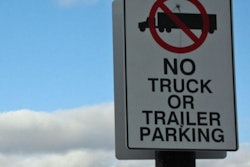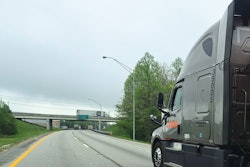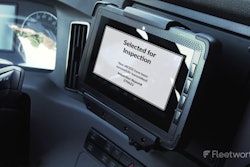AMID RECORD DIESEL PRICES, TRUCKERS DEMAND RELIEF
The national average retail price of a gallon of diesel increased a whopping 16 cents in the week ending Aug. 15, to set a new record of $2.567 – a 74-cent increase from the same week of 2004.
As prices continued to rise through the summer, truckers from the Pacific Northwest to South Florida began to agitate for relief in the form of fuel surcharges.
Tracy Lutton, who owns a log trucking company based in Aberdeen, Wash., is one of many feeling frustrated by negotiations with shippers.
“The timber companies have always told us what they would pay us, because we are a small, specialized industry,” Lutton says. “Now that the fuel price is getting up, we are getting to where we can’t run. They still want to pay us an amount that goes back to almost the 1980s.”
In protest, 200 members of the Northwest Log Truckers Co-Op parked their trucks Aug. 10. “Everybody decided enough was enough,” Lutton says.
The same day, on the other side of the continent, 652 owner-operators roared bobtail from Hialeah, Fla., to the Miami City Hall in a Teamsters-led protest demanding an adequate surcharge.
Many truck stops in mid-August were charging much more than the national average, said Chris Lee, marketing director of ProMiles, which tracks fuel prices nationwide.

“Since we’ve broken the $3 barrier, first in Canada and now out in California, we are starting to see occasional prices above $3 a gallon in other states as well, still primarily in the West,” he said Aug. 16. “Today I am seeing 78 truck stops reporting a price over $3 a gallon, which is scary enough in itself, but close to 400 truck stops are reporting a price in excess of $2.75.”
There’s plenty of blame to go around, Lee says: a surprisingly active hurricane season that has hampered oil refining in the Gulf of Mexico; early forecasts for a cold winter that have increased demand for heating oil; and production caps by the Organization of Petroleum Exporting Countries.
In Washington state, the fuel tax went up 3 cents a gallon in July; it’s scheduled to go up another 6.5 cents a gallon over four years. A citizens’ initiative to repeal the gasoline tax increase is on the November ballot, but even if it passes, it won’t help diesel buyers.
The Washington Trucking Association will ask the Legislature for diesel tax relief if the gasoline repeal passes, says Norm Miller, an association vice president.
In the meantime, only a few timber companies have been responsive to the co-op’s requests, Lutton says.
“Some are coming up and paying a surcharge that we like,” Lutton says. “We needed 22 percent. The worst problem is that the lumber trucks and the chip trucks and the freight trucks come out with 22 percent, and we are driving out with 10 to 11 percent.”
The owner-operators in Miami delivered a letter to Miami City Commissioner Thomas Regalado. Mike Scott, president of Teamsters Local 174, says the letter requested what many truckers have sought for years – an act of Congress mandating that fuel surcharges be passed along to whoever pays for the fuel.
–LANCE ORR
BILL HAS NO SURCHARGE, NO HOURS RULE
After years of negotiations, compromises and veto threats, Congress finally passed legislation to fund highway safety and construction programs, including oversight of motor carriers. President Bush signed it into law Aug. 10.
The $286 billion spending plan – a higher figure than Bush originally said he would agree to – seems to include something for everybody, including the trucking industry. But it does not include the mandatory truckload fuel surcharge, paid by shippers, that many owner-operators and small fleets had hoped for. The American Trucking Associations successfully fought the surcharge, which was supported by the Truckload Carriers Association and the Owner-Operator Independent Drivers Association.
The plan also does not write into law the 2004 hours-of-service rule, a strategy sought by the Bush administration and many in the industry.
The legislation expands and makes permanent the agricultural exemption to the hours regulations.
Drivers in other industries got hours exemptions as well. The exemptions cover such specific industries that they won’t affect the majority of owner-operators, says Rick Craig, OOIDA director of regulatory affairs.
For example, drivers for movie producers can rest eight hours daily, instead of the standard 10 hours, on routes within 100 miles of production sites. Propane haulers also get an exemption during winter months and during pipeline emergencies.
The plan also limits tolls on existing interstate highways, but that any such tolls were OK’d troubled the ATA, which calls tolls “an inefficient funding mechanism that double-taxes motor carriers and causes substantial diversion of traffic to other, less safe roads.”
The legislation also makes it easier for insulin-dependent diabetics to haul interstate with a commercial driver’s license, allowing them to be assessed on a case-by-case basis and eliminating the three-year experience rule. Twenty-seven states already grant diabetics waivers for in-state driving, which is legal under federal law.
The spending plan also:
- Allocates $5 million for truck driver training;
- Funds enforcement of traffic violations by other motorists around commercial trucks;
- Revises the screening process for hazmat drivers, requiring the Transportation Security Administation to eliminate redundant background checks and to notify carriers if a driver fails to meet security criteria;
- Gives pre-employment screening services greater access to driver safety information in FMCSA’s Motor Carrier Management Information System, including accident and violation reports;
- Drops the registration requirement for freight forwarders and brokers, but allows the U.S. Department of Transportation to require registration at its discretion;
- Allows DOT to shut down carriers if an officer has engaged in noncompliance;
- Adopts safety regulations for intermodal equipment;
- Sets standards for a unified carrier registration system.
For a copy of the final legislation, visit thomas.loc.gov and search H.R. 3.
–AVERY VISE AND LANCE ORR
BILL INCLUDES DIESEL RETROFITS
On Aug. 8, as oil hit a record $63 a barrel, President Bush signed an energy bill praised by the American Trucking Associations for easing the costs of emissions-reducing equipment and promoting renewable fuels.
The law creates the Diesel Truck Retrofit and Fleet Modernization Program. It allows public agencies to compete for $100 million in grants over three years for diesel retrofits or newer equipment. Additionally, carriers will be eligible for $200 million in retrofit grants through the bill’s Diesel Emissions Reduction provision.
The bill also provides $94.5 million in grants for idle reduction and energy conservation technologies through the SmartWay Transport Partnership over three years. SmartWay is an Environmental Protection Agency initiative involving fleets and other private parties.
The final bill dropped – for now – the Bush goal of opening Alaska’s Arctic National Wildlife Refuge to oil drilling. Still, congressional supporters hope to pass that provision this year.
“The push toward renewable fuels and investments in new refining capacity serve to prevent high fuel prices from limiting the long-term potential of the economy while also easing the fuel needs of our industry,” ATA President Bill Graves says.
Bush says the law will provide incentives to domestic oil, natural gas, coal and nuclear energy suppliers and alternative energy sources. Democrats counter that the law will do nothing to significantly reduce America’s dependence on foreign oil or to reduce America’s contribution to global warming.
–JILL DUNN
TRUCK-RELATED FATALITIES INCREASE
Highway fatalities involving large trucks increased 3 percent, from 5,036 in 2003 to 5,190 in 2004, the National Highway Traffic Safety Administration announced.
This does not, however, imply that truckers are at fault for the increase, says NHTSA spokesman Eric Bolton.
“All we are doing is quantifying the accidents that occur and what kinds of vehicles were involved,” he says.
A more accurate gauge of truck safety will be the Federal Highway Administration’s fall report that tallies the number of fatalities per million heavy-truck miles traveled, says American Trucking Associations spokesman Mike Russell. ATA expects those numbers “to confirm that truck safety continues to improve,” Russell says.
The total number of U.S. highway fatalities in 2004 was 42,636, the least since recordkeeping began 30 years ago. As a percentage, the biggest decrease was in the District of Columbia, where highway fatalities dropped 36 percent. The biggest percentage increase was in Vermont, where highway fatalities increased 42 percent.
The overall fatality rate per 100 million vehicle miles traveled was 1.46. The rate has been improving since 1966, when 50,894 people died and the rate was 5.5.
–LANCE ORR
FMCSA STUDY: MOST DRIVERS NOT PUSHING LOG LIMITS
A newly released Federal Motor Carrier Safety Administration study shows one in five over-the-road drivers exceeded 10 hours of driving during the course of their regular duties.
Additionally, drivers rarely worked more than 13 hours in an on-duty cycle, and those who used split sleeper berth provisions typically had one period of six hours or greater.
When FMCSA revamped the 70-year-old hours of service rule in 2003, it extended the number of hours a driver could drive in a single duty cycle from 10 to 11, retained sleeper berth exemptions and added the 34-hour restart provision. All those elements have been criticized by safety advocates, though they were retained in the new rule announced in August by FMCSA – the sleeper berth provision in modified form.
The agency collected data from the logbooks of 542 drivers at 269 carriers during compliance reviews in January and February. FMCSA excluded drivers who were found to have falsified their records.
Key findings include:
- 21 percent of driving periods exceeded 10 hours of driving, as allowed under the 2004 hours of service rule. For over-the-road drivers, 23 percent exceeded 10 hours;
- 15 percent of on-duty periods exceeded 12 hours on duty, and 9 percent exceeded 13 hours. For over-the-road drivers, 16 percent exceeded 12 hours, and 9 percent exceeded 13 hours;
- 68 percent of sleeper berth periods exceeded six hours, and 53 percent exceeded eight hours; and
- More than 70 percent of the participating drivers used the 34-hour restart provision of the rule. Most recovery periods exceeded 44 hours, while 15 percent had recovery times of less than 36 hours.
–SEAN KELLEY
DOT NUMBER DISPLAY NOW BEING ENFORCED
The Federal Motor Carrier Safety Administration has begun enforcing the rule mandating that commercial motor vehicles must display an active, valid U.S. Department of Transportation number.
The rule, which became effective July 5, affects all trucks weighing more than 10,000 pounds, all vehicles transporting hazardous materials and many passenger carriers.
All such vehicles must show the name of the carrier and the carrier’s DOT number on both sides of the vehicle. Leased owner-operators must show the number of the carrier they are leased to. Some states require owner-operators to obtain their own number before their International Registration Plan license plates are renewed.
Some states have truck marking regulations that match the federal regulations: Alabama, Colorado, Florida, Georgia, Iowa, Kansas, Kentucky, Michigan, Minnesota, New York, Ohio, Oregon, South Dakota, Tennessee, Utah, West Virginia and Wisconsin. Intrastate hauling within these states requires a DOT number.
Vehicles without the properly displayed number are subject to fines. In New York, for example, the civil penalty can be as high as $5,000.
–LANCE ORR
SHORT HAULS
THE TEAMSTERS UNION withdrew its membership from the AFL-CIO, joining six other renegade unions in a new Change To Win coalition representing
5 million workers.
ON-BOARD DIAGNOSTICS for emissions control will be mandatory in heavy-duty engines sold in California by 2016, the state Air Resources Board has decided.
PRIME INC. agreed to buy 3,000 ArcticLite refrigerated vans from Wabash National in the next three years, with an option for more.
KRIETE GROUP of Milwaukee opened new facilities in Green Bay and Racine, giving the Mack and Volvo distributor five dealerships in east-central Wisconsin.
UTILITY TRAILERS of New England, based in Boston, opened a second location in Hopedale, Mass.
DAN CLARK, an owner-operator leased to Prime Inc., is MultiMedia’s August Trucker Buddy Driver of the Month. Clark corresponds with Lynn Schnoor’s first-graders at Fir Grove Elementary in Roseburg, Ore.
LOVE’S TRAVEL STOPS opened a location on I-10 in Chandler, Ariz., its first to have a dedicated fuel lane for RVs.
PETRO opened a location on I-65 in Remington, Ind.
THE TRANSPORTATION SERVICES INDEX for freight increased half a point in May to 113.1, the U.S. Department of Transportation reported. It was the third monthly increase in a row.
THE MIDNIGHT TRUCKING Radio Network inducted eight new members into its Million Mile Club, sponsored by Chevron Delo, in July: Eugene Clements, Brooks Dees, Gene Hipps, Don Keyser, Allen Moore, Ernie Schneider, Ralph Taylor and Gary Volkers.
MARTEN TRANSPORT has added intermodal services to its operation.
ONE LUCKY DONOR to Living Word Fellowship of Hickory, N.C., will win a 2006 Peterbilt 379 in a Nov. 20 drawing. Every $100 donation to the church’s homeless ministry will earn a chance. Visit this site.
FREIGHTLINER has a redesigned website, www.freightlinertrucks.com. Users can search for vehicles by model or application.
GT DEVELOPMENT, maker of air, brake and fuel system components and cab and seat controls, has an updated website at www.gtdev.com.
SLOAN TRANSPORTATION PRODUCTS has a new 200-page catalog of air and electrical components, including more than 1,000 new part numbers. Call (800) 336-7778 or visit this site.
HIGHWAY HAPPENINGS
GEORGIA. Rebuilding four miles of I-20 in DeKalb County, east of Atlanta, will cause occasional delays until February.
MARYLAND. An electronic fog warning system has been installed along I-68 in Garrett County, where heavy fog on Big Savage Mountain caused a fatal 89-vehicle pileup in 2003.
MICHIGAN. Involved parties now can access crash reports online for a $10 fee. Go to www.michigan.gov/msp, and click on “TCPS” (for Traffic Crash Purchasing System).
NEW HAMPSHIRE. U-turns are not recommended at the inter-section of routes 171 and 109 in Moultonborough, near the Castle Springs bottling plant. Big rigs often get stuck in the attempt because of severe road crowns.
NEW YORK. Work begins this month on repaving the rutted and potholed New York Thruway between Spring Valley and Nyack, west of the Hudson. Expect lane closures at night through November.











